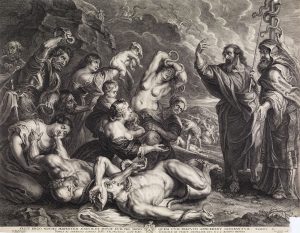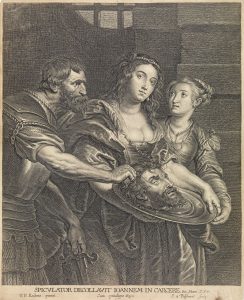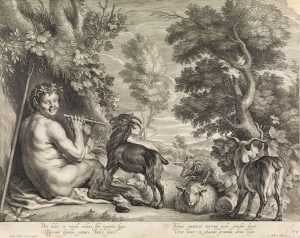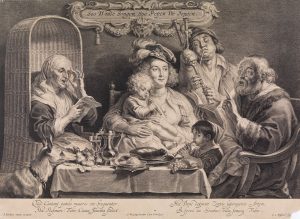Flemish baroque engravings donated to the Print Collection
A group of 14 Flemish baroque engravings by Scelte Adams Bolswert (1586–1659) was gifted to the Baillieu Library Print Collection by Dr Colin Holden in 2016. Bolswert was employed by the eminent artist, Peter Paul Rubens (1577-1640) and several of these prints are after Rubens’ paintings.
The Flemish Region, or Flanders, a Dutch-speaking area of Belgium, furnished a tumultuous political and social backdrop to its flourishing baroque art of the 17th century. Rubens was the foremost painter in Antwerp, its capital, and he relied on pupils and studio assistants to help produce his extensive and influential body of work. He was not a printmaker, but recognised the medium’s importance to his career and actively commissioned engravings after his designs. [1]
Many of Rubens exuberant subjects are biblical, such as Moses and the Brazen Serpent (1640-60). This engraving illustrates the episode in which the discontented Israelites, who were left to trudge through the lands of Edom, spoke against God and Moses. In punishment, God sent a plague of poisonous serpents to attack them, which is vividly depicted by the roiling bodies. The Israelites sought Moses’ help, who in turn received the remedy from God. Moses, seen at left with a staff, made a snake out of brass and set it on a pole: the brazen serpent. All the people that were stricken were healed by gazing upon it.
The New Testament subject, Salome Receiving the Head of St John from the Executioner (1638-59) depicts the notorious story of Herodias’ daughter Salome, holding the head of the preacher on a charger. The expressions of the figures portrayed evoke a range of emotions.
Pan, Playing the Flute (1638-59) engraved after Flemish artist Jacob Jordaens, in contrast, is a mirthful scene from classical mythology. The gift included four impressions of this image, in three states. A ‘state’ in printmaking is created when a change is made to the engraving plate, for example further details are added to the inscriptions, or details in the image are adjusted. Students studying prints will benefit from seeing, in these prints, the execution of different states.
Also after Jordaens, The family concert (1630-59) includes another title in the cartouche at the top of the image which translates: ‘As the old sing, so the young pipe.’ This and other moralising Dutch sayings and proverbs were popular in the 17th century as this engraving illustrates. Likewise the compositional motif of a family gathered around a table appears in several works of art of this period. The engaging dog seen at left of the image is intent not on the nourishing mores offered by the picture, but instead longs to devour the feast!
The late Dr Colin Holden (1951-2016) was a great friend of the Print Collection. He was print scholar, collector and a senior fellow of the School of Historical and Philosophical Studies at the University of Melbourne.
Kerrianne Stone (Curator, Prints)
Reference
[1]. Art Gallery of South Australia, The age of Rubens & Rembrandt: Old Master prints from the Art Gallery of South Australia: Dutch and Flemish etchings, engravings and woodcuts from the sixteenth and seventeenth centuries by Julie Robinson, Adelaide: Art Gallery Board of South Australia, 1993, p. 33
Categories
- Uncategorised
- Prints




Leave a Reply